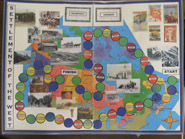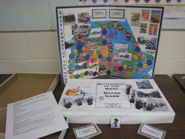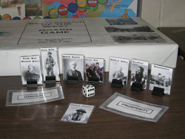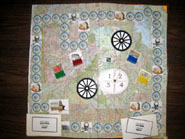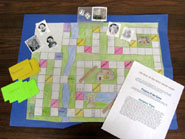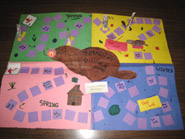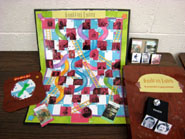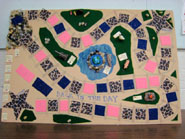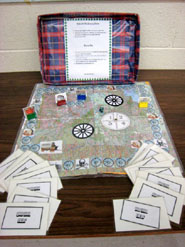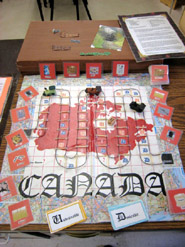 THE HOMESTEAD BOARD GAME
THE HOMESTEAD BOARD GAME
THE BOARD
Have a START & FINISH square. Draw a track of your design. You may use the suggested CARDS below or create your own. Include what these cards do. (Start over, move ahead 2 spaces, change places with the first place player, etc…)
Use lots of colour. Include diagrams / images that represent the pioneer times of
Including a box or bag for your game might help. Most board games have
a folding design.
GOOD LUCK CARDS - examples
Build first sod house
Plant first crop
Harvest first crop
Hold barn-raising
Railway built 2 miles from your homestead
Build wooden house
Sell vegetables to train passengers
Cow has calf
Neighbour helps you fence homestead
Cut enough hay for winter feed
Get summer job on railway
Dig well, find water
Letter from lawyer: you inherited $1000
A child is born
BAD LUCK CARDS - examples
Grasshoppers eat crop
Drought ruins crop
Flood covers plowed field
Prairie fire destroys house
Hail flattens crop
Child sick: no doctor available
Horse dies in blizzard
Winter livestock feed runs out in February
Well-digger cannot find water on your homestead
Gophers eat your vegetables
CREATE YOUR PIECES TO
MOVE
Be creative. Make monopoly like pieces. Use clay or drawings or items that represent pioneer times. Eg. Wagon wheel, livestock, crop, household item, train, cart, etc…
WRITTEN INSTRUCTIONS
Create your own written instructions explaining game play. Be specific. Explain the rules, how your “shortcuts” or “detours” work and how a winner is determined.
(First one that does 2 laps of the board or most money at the end?) What type of die is to be used? (4,6,8 or 10 sided)
SUGGESTIONS
Typed cards and instructions will help all ages play your game. It’s also more professional. Your average game should be ~ 10 – 15 minutes long. You want to have ~ 40 – 65 squares. Including twists of fate like coin tosses, spinners, switching spots, number guesses, etc… make the game more exciting.
EVALUATION:
·
Effort / Creativeness
·
Information
·
Appearance
·
Completeness
· Timeliness
